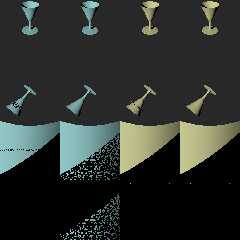Documenting long standing exposures with the sor tutorial example.
Ref:
https://wiki.povray.org/content/Documentation:Tutorial_Section_3#Index_Entry_sor_tutorial
---
The cocktail outline has a flattish portions which are difficult for the
solvers to handle. Similar to the lathe, the sor likes curvature in the
spline used (excepting linear splines with the lathe).
In the attached image, the blue results come from v3.8 beta 2, the
yellow from R20 of yuqk. No AA to better see the issues.
The two columns for each version of POV-Ray represent the non-sturmian
solver and then the sturmian solver.
The bottom two rows put the camera into the cocktail. The very bottom
row adds caps and the results 'should be' completely black.
Notes:
a) The non-sturmian solver has difficultly in both v3.8 beta 2 and
yuqk(R20) given certain ray approaches.
b) The sturmian solver has trouble too in v3.8 b2 - in the shadow
regions of the top row, for example.
c) The sturmian solver in yuqk returns clean results for all the
examples run.
d) The yellow pixels at the very top of the yuqk results in the lower
right are due the intersections hitting deep in the crevice between the
lip of the cocktail form and the cap.
When the intersection is closer to the cap plane than the internal
shadow tolerance value (1e-3) shadow rays see through to lights. The
artifacts exist in both v3.8 and yuqk at larger image sizes.
The yuqk fork has the 'shadow_tolerance' global setting which allows the
default 1e-3 value to be reduced - greatly reducing the likelihood
shadow rays will see through the cap due the shadow tolerance value. The
exposure never goes completely away in situations like this. AA often
helps hide these issues when they come up.
Bill P.
Post a reply to this message
Attachments:
Download 'tutorialsorissues.png' (75 KB)
Preview of image 'tutorialsorissues.png'

|




![]()